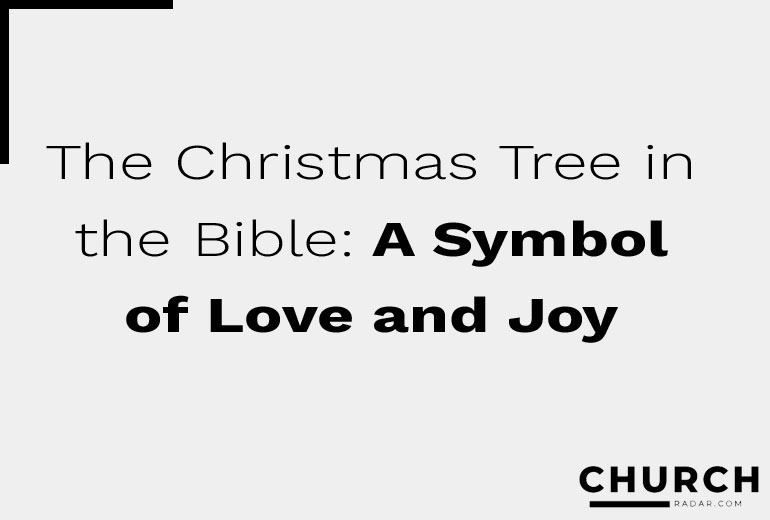The Christmas Tree in the Bible: A Symbol of Love and Joy
- 2023-11-07 by
- ChurchRadar

When we think of Christmas, one of the first images that comes to mind is the beautifully adorned Christmas tree. However, the Christmas tree is not explicitly mentioned in the Bible. Instead, its roots can be traced through various historical, cultural, and religious influences. In this article, we explore the symbolism and evolution of the Christmas tree tradition, shedding light on its unique role in celebrating Christ's birth.
- Jeremiah 10:1-5
- The Symbolism of Trees in the Bible
- The Origins of the Christmas Tree Tradition
- Pagan Roots and Christian Adaptations
- The Evergreen Tree as a Christian Symbol
- Martin Luther and the Tradition of Lighted Trees
- The Christmas Tree's Evolution in Different Cultures
- The Modern Christmas Tree and Its Significance
- Decorating the Christmas Tree with Christian Symbols
- The Biblical Message of Love and Joy in the Christmas Season
- The Christmas Tree's Unique Role in Celebrating Christ's Birth
Jeremiah 10:1-5
It is a passage from the book of Jeremiah in the Old Testament of the Bible. Here is the passage:
"1 Hear the word which the Lord speaks to you, O house of Israel. 2 Thus says the Lord:
Do not learn the way of the Gentiles;
(Jeremiah 10:1-5, NKJV)
Do not be dismayed at the signs of heaven,
For the Gentiles are dismayed at them.
3 For the customs of the peoples are futile;
For one cuts a tree from the forest,
The work of the hands of the workman, with the ax.
4 They decorate it with silver and gold;
They fasten it with nails and hammers
So that it will not topple.
5 They are upright, like a palm tree,
And they cannot speak;
They must be carried,
Because they cannot go by themselves.
Do not be afraid of them,
For they cannot do evil,
Nor can they do any good."
This passage is often cited in discussions about the use of trees in religious or cultural practices, but it is important to note that its context is different from the modern Christmas tree tradition. The passage in Jeremiah is more focused on cautioning against idolatrous practices and superstitions associated with trees, rather than addressing the specific use of evergreen trees as Christmas decorations.
The Symbolism of Trees in the Bible
Trees have held special significance in the Bible since ancient times. They are often used as symbols of life, growth, and strength. For instance, the Tree of Life in the Garden of Eden and the Cedars of Lebanon are notable biblical references to trees.
The Origins of the Christmas Tree Tradition
The practice of decorating evergreen trees during winter celebrations predates Christianity. In ancient pagan cultures, people believed that evergreen trees symbolized the persistence of life during the cold, dark winter months. The early Christians adopted this custom, transforming it into a symbol of hope in Christ's eternal life.
Pagan Roots and Christian Adaptations
As previously mentioned, the custom of decorating trees during winter festivities had pagan origins. The Christian adaptation of this practice began in the Middle Ages, with the evergreen tree serving as a reminder of the hope and life found in Christ.
The Evergreen Tree as a Christian Symbol
The evergreen tree, with its enduring greenery even in winter, came to symbolize the everlasting life offered through faith in Jesus. Its triangular shape was seen as a representation of the Holy Trinity.
Martin Luther and the Tradition of Lighted Trees
The tradition of lighting Christmas trees is often attributed to Martin Luther, the Protestant Reformer. As the story goes, he was inspired by the beauty of the starry night and brought a lit tree into his home to share the experience with his family. This practice of adding candles to the tree has endured through the centuries.
The Christmas Tree's Evolution in Different Cultures
The Christmas tree tradition evolved differently in various cultures. In Germany, the Christmas tree became a central symbol of the holiday. In the United States, the practice was popularized by German immigrants in the 18th and 19th centuries.
The Modern Christmas Tree and Its Significance
Today, the Christmas tree is a cherished symbol of the holiday season, representing love, unity, and the hope of Christ's birth. Families come together to decorate their trees with lights, ornaments, and garlands, creating a sense of togetherness and joy.
Decorating the Christmas Tree with Christian Symbols
Many families choose to incorporate Christian symbols into their Christmas tree decorations. This can include nativity scene ornaments, crosses, angels, and other reminders of the true reason for the season.
The Biblical Message of Love and Joy in the Christmas Season
While the Christmas tree is not mentioned in the Bible, it aligns with the biblical message of love, joy, and hope that Christ's birth represents. It serves as a beautiful reminder of the gift of God's love to humanity.
The Christmas Tree's Unique Role in Celebrating Christ's Birth
The Christmas tree, with its rich history and symbolism, plays a unique and beloved role in celebrating the birth of Jesus. It brings families together, inspires acts of love and kindness, and fills our homes with the warmth and joy of the holiday season. As we gather around the tree, may we remember the true meaning of Christmas and the boundless love it represents.


